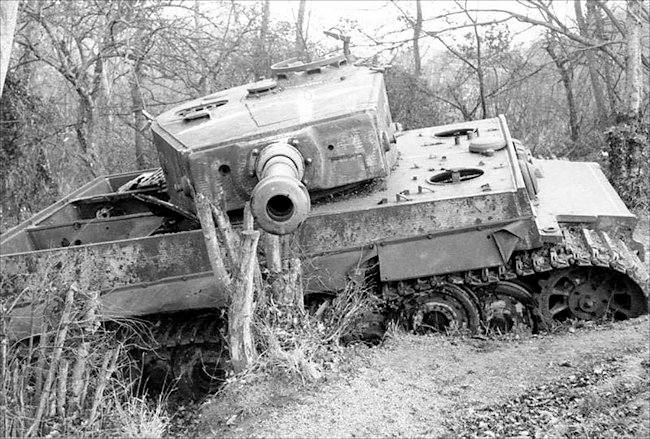
Vimoutiers Tiger
During August 1944, the German Wehrmacht lost a good deal of equipment during the closing of the Falaise pocket. On the 21st of August some five German vehicles found themselves eastward of the city of Falaise where they squeezed through the Falaise Gap. They managed to escape the pocket and headed towards the Guerquesalles area.
Approximately 5 km from the city of Vimoutiers on the road to Gracé the Tiger and some other vehicles came to a halt – probably due to fuel shortages – and weren’t able to climb the steep hill they were facing. The Tiger crew abandoned their vehicle and rendered it inoperable by means of two explosive charges.

Not much later, the area was overrun by Allied forces and the abandoned vehicles were bulldozed to the roadside to make way for traffic. The Tiger became stuck in an awkward position on a downwards incline. After the war, this meant that the Tiger was hard to reach and so didn’t became victim to complete scrapping – only some easy to reach items were removed from the vehicle. After gaining attention through a publication in ‘After the Battle’ No. 8, existing plans to scrap this Tiger were halted. Later in the 1970s the Tiger was bought by the Vimoutiers city to be displayed be put up as a monument in 1975 of the events that took place there in 1944.
Nowadays, this Tiger still stands proud close an incline along the D797 heading from Vimoutiers to Gracé where it originally stranded. Last week I was able to visit this extraordinary monument.
This Tiger provides an excellent opportunity to take some very detailed shots that would otherwise not be possible – or would need special permission – on museum vehicles.
Hull details
I’ll start off with some of the details of the hull:
Turret
Here’s a closer look at the typical horseshoe shaped turret. Note the lettering on top of the gun mantlet. Typically, large casted parts would have a batch number and a three-letter code which identified the manufacturer and would presumably help with quality control of casted items. The letters ‘amp’ are known to belong to Dortmund-Hörder Hüttenverein (DHHV). Note that in German a ‘Hütteverein’ is nothing less than a foundry union. Early Tigers had two apertures for the binocular Turmzielfernrohr (T.Z.F). 9b gun sight, but as can be seen this Tiger has a single opening for the monocular T.Z.F. 9c sight which was introduced into production in April 1944. In that same month also the Nahverteidigungswaffe, litteraly close-defence weapon, was introduced. This small grenade launcher could launch a range of projectiles (smoke, grenade, signal flares) at an angle of 50° and was fully traversable.
Interior
Some convenient damage to the armour plates gives one the opportunity to not only inspect the exterior of this Tiger, but also the interior.
Engine bay
Although most of the internals of this tank are missing, I was surprised to find the original engine is still inside. The explosion seems to have ripped out the dividing wall between the engine bay and crew compartment as well as part of the separator wall between engine and cooling vents.
Fighting Compartment & Turret
Poking my camera through the hole originally meant for the fuel filler cap provided a nice angle on the rest of the interior. Taking these photos was only made possible due to the dividing wall between the fighting compartment and engine bay being absent (i.e. destroyed by the internal explosion).
Some light is seeping in from the very front of the tank where the welds cracked. Some of the foremost ammo racks are still in place in the sponsons. While the interior of this tank would have been mostly white, it’s only scarcely visible. It seems the gun elevation mechanism in completely busted. The only thing preventing the gun from depressing entirely is a block of concrete. All the hatches were scrapped and have been welded shut with some metal plates.
Suspension and running gear
As can be seen in the photos of the interior, many of the torsion bars running perpendicular along the length of the hull are broken. The Tiger was placed on a concrete bedding to be able to stand up. Looking at the clearance between the sponsons and the tracks it becomes clear that most of the suspension indeed collapsed. Most noticeably at the portside the clearance between hull and track is second to none. Below is a comparison to the Tiger found in Musée de Blindes, Saumur, France which has a functioning suspension.
Whereas the Vimoutiers Tiger has the wide combat tracks Geländekette (725 mm) fitted, the Tiger in Saumur sports the much narrower transport tracks Verladekette (520 mm).
That’s it for now, hope you’ve enjoyed this post. If you’re missing any detail shots of the Tiger in particular, be sure to post a request in the comment section – I have tons of additional detail photos that I haven’t posted here as I felt I would be a bit too much





































